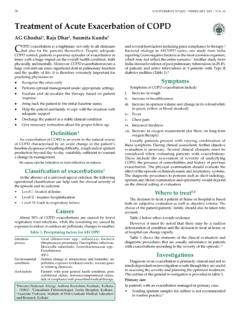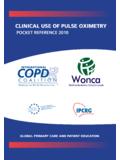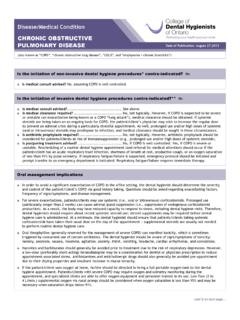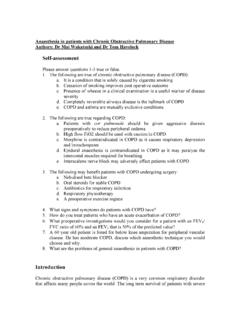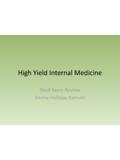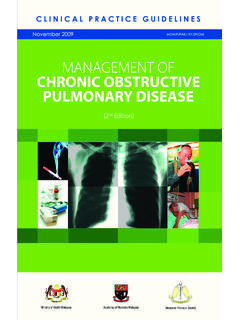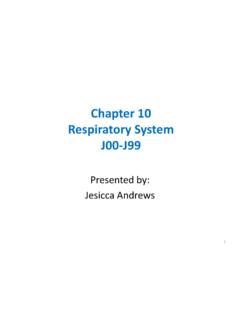Transcription of Course Handouts & Disclosure - homecareinformation.net
1 1 copd :Disease Trajectory and Hospice EligibilityTerri L. Maxwell PhD, APRNVP, Strategic InitiativesWeatherbee ResourcesHospice Education NetworkCourse Handouts & Disclosure To download presentation Handouts , click on the attachment icon Presenter discloses no financial relationships with a commercial entity producing products and/or services. Conflict of interest Disclosure and resolution statement is on file with HEN. This presentation is for educational and informational pu rposes only. It is not intended to provide legal, technical or other professional services or Objectives List the stages and clinical Course of copd State symptoms experienced by patients with copd Identify secondary and conditions commonly associated with copd Explain issues experienced by copd patients and their caregivers Describe the basic management and treatment of copd Name the clinical data points necessary to substantiate hospice eligibility for patients with COPDH ospice Education Network - Disease Specific Clinical Eligibility & Documentation.
2 COPDH ospice Education Network (c) 20122 Chronic Obstructive Pulmonary Disease ( copd ) Respiratory disorder characterized by chronic airway obstruction and lung hyperinflation 12 million diagnosed with copd 4thleading cause of death in the US Death rate for copd has doubled over past 30 yrs, largely due to exposure to tobacco smoke and is expected to climb to 3rdby 2020 Jemal, Ward, Hao, Thun. JAMA. 2006, 295(4): Attributes of fully disease that generally worsens over time, even with treatment inflammatory responseCelli BR et al. Eur Respir J. 2004;23 of COPDS mall airway diseaseAirway inflammationAirway remodelingParenchymal destructionLoss of alveolar attachmentsDecrease of elastic recoilHospice Education Network - Disease Specific Clinical Eligibility & Documentation: COPDH ospice Education Network (c) 20123 Factors Determining copd Severity Degree of symptoms Frequency and se verity of exacerbations Presence of that can lead to complications General health status Number of medications needed to manage disease Severity of spirometric abnormality/airflow limitationCOPD SeveritySeverity of airflow obstructionFEV1 % <30%Spirometry is the gold standard for diagnosing copd .
3 Severity is measured by FEV1 Note: FEV= Forced Expiratory VolumeSpirometry: Normal vs COPDH ospice Education Network - Disease Specific Clinical Eligibility & Documentation: COPDH ospice Education Network (c) 20124 Stages of COPDS tage I: Mild copd : FEV1/FVC < ; FEV1 80% predicted. Patient unaware lung function is abnormalStage II: Moderate copd : FEV1/FVC < ; 50% FEV1 < 80% predicted. Patient typically seeks medical attention because of pulmonary symptomsAdapted from GOLD Guidelines, 2007 Stages of copd (cont d)Stage III: Severe copd : FEV1/FVC < ; 30% FEV1 < 50% predicted. Greater shortness of breath, reduced exercise tolerance, decreased quality of lifeStage IV: Very Severe copd : FEV1/FVC < ; 30% FEV1 < 50% predicted pl us the presence of chronic respiratory failure.
4 May have signs of cor pulmonale and usually oxygen from GOLD Guidelines, 20072 Natural History of COPDFEV1 <70. dyspnea with exercise FEV1 <45. exacerbations /hospitalizations/dsypneawi th ADLs FEV1<30. Systemic effects/dyspnea at rest/respiratory failure Hospice Education Network - Disease Specific Clinical Eligibility & Documentation: COPDH ospice Education Network (c) 20125 copd and ConditionsCommon : Cardiovascular disease Lung cancer Osteoporosis Musculoskeletal disorders Depression/anxiety Obesity/type II diabetesSystemic Effects of copd Peptic ulceration Lung infections/lung cancer Weight loss/muscle wasting and weakness Osteoporosis DepressionNOTE.
5 If caused by the copd , these could be co nsidered secondary (RELATED) Signs & Symptoms Dyspnea Wheezing Cough Hypoxemia and rising CO2 levels Pulmonary hypertension that may progress to right ventricular hypertrophy and cor pulmonale( heart failure)Hospice Education Network - Disease Specific Clinical Eligibility & Documentation: COPDH ospice Education Network (c) 20126 acute copd Exacerbation Definition: Sustained worsening of symptoms from patient s usual condition; acute in onset Symptoms Increased shortness of breath Increased sputum production and/or increase in purulence Increase cough Increased wheeze/chest tightness Decreased exercise tolerance Increased fatigue Altered mental statusNICE GUIDELINES 2004IV: Very SevereIII: SevereII: ModerateI: MildTherapy at Each Stage of copd FEV1/FVC < 70% FEV1 > 80% predicted FEV1/FVC < 70% 50% < FEV1 < 80%predicted FEV1/FVC < 70% 30% < FEV1 < 50% predicted FEV1/FVC < 70% FEV1 < 30% predictedorFEV1 < 50% predicted plus chronic respiratory failureAddregular treatment with one or more long-acting bronchodilators (when needed).
6 AddrehabilitationAddinhaled glucocorticosteroids if repeated exacerbationsActive reduction of risk factor(s); influenza vaccinationAddshort-acting bronchodilator (when needed)Addlong term oxygenif chronic respiratory failure. Considersurgical treatmentsAdapted from GOLD Guidelines. of copd Stage IV: Very Severe COPDC haracteristics Recommended Treatment FEV1/FVC < 70% FEV1 < 30% predicted orFEV1 < 50% predicted pluschronic respiratory failure bronchodilator as needed Regular treatment with one or more LA bronchodilators Inhaled glucocorticosteroidsif repeated exacerbations Treat complications Rehabilitation O2 therapy if respiratory failure Consider surgical optionsAdapted from GOLD Guidelines, 2007 Hospice Education Network - Disease Specific Clinical Eligibility & Documentation.
7 COPDH ospice Education Network (c) 20127 Advanced copd Management and bronchodilators (albuterol) Anticholinergics (ipatropium bromide or tiotropium) Methylxanthines (theophylline) Combination inhaled therapies (formoterol/budesonide) Inhaled corticosteroids. note: long term oral steroids are not recommended; however, day Course of prednisone may be helpful for exacerbationsAdapted from GOLD Standards, 2007 Management of Advanced copd (cont d) Antibiotics reserved to treat infections; do not use prophylactically Opioids oral and parenteral (not nebulized) to treat dyspnea Anxiolytics helpful in managing an xiety associated with dyspnea Oxygen therapy should be worn 15 hrs or > per day for greatest benefitEnd of Life Issues Prognosis is difficult to predict Palliative care should be based upon patient symptoms and functional status Frequent exacerbations requiring trips to the ED and/or hospitalizations Patients and family members frequently do not comprehend the terminal nature of the illness Lack of communication and advanced care planning Isolation/depression/anxietyHospice Education Network - Disease Specific Clinical Eligibility & Documentation.
8 COPDH ospice Education Network (c) 20128 Signs that Patient Requires Palliative Care FEV1 < 30% predicted History of 2 or more exacerbations in past year Frequent hospitalizations Progressive shortening of intervals between admissions Limited improvement after hospitalizationSupporting Indicators Declining functional status/homebound Presence of such as heart failure or diabetes On maximum therapy and dependence on oxygenLCD Guidelines for Hospice Eligibility and Recertificationfor COPDNGS LCD Number L25678 CGS LCD Number L32015 NHIC LCD Number L29881 Hospice Education Network - Disease Specific Clinical Eligibility & Documentation: COPDH ospice Education Network (c) Specific GuidelinesBoth A & B must be met: functional status- KPS <70 or PPS < on assistance for 2 or > of that contribute to disease burden HF Diabetes Dementia, Specific Guideline:Pulmonary Disease 1.
9 Severe chronic lung disease as documented by both a and b:a. Disabling dyspnea at rest, poorly responsive or unresponsive to bronchodilators, resulting in decreased functional capacity, , existence, fatigue, and cough. (Documentation of FEV1, after bronchodilator, less than 30% of predicted is objective evidence for disabling dyspnea, but is not necessary to obtain.)Pulmonary, Cont Progression of end stage pulmonary disease, as evidenced by: increasingvisits to the emergency department or hospitalizations for pulmonary infections and/or respiratory failure or increasing physician home visits prior to initial certification. (Documentation of serial decrease of FEV1>40 ml/year is objective evidence for disease progression, but is not necessary to obtain.)
10 Hospice Education Network - Disease Specific Clinical Eligibility & Documentation: COPDH ospice Education Network (c) 201210 Pulmonary, Cont Hypoxemia at rest on room air as evidenced by: pO2 less than or equal to 55 mmHg; or oxygen saturation less than or equal to 88%; or hypercapnia as evidenced by pCO2 greater than or equal to 50mmHg. (These values may be obtained from recent [within 3 months] hospital records.)Pulmonary (supportive)3. Cor pulmonale (right heart failure) secondary to pulmonary disease ( , not secondary to left heart disease or valve disease)4. Unintentional progressive weight lossof greater than 10%of body weight over the preceding 6 months5.
